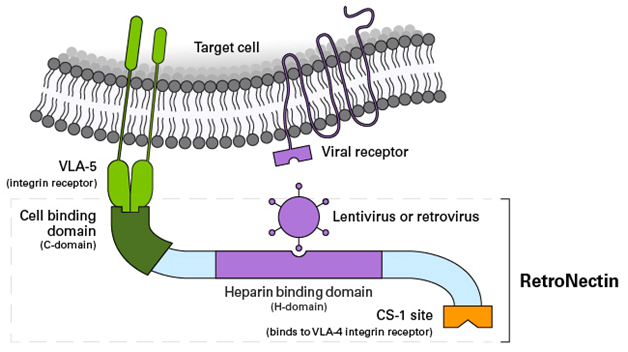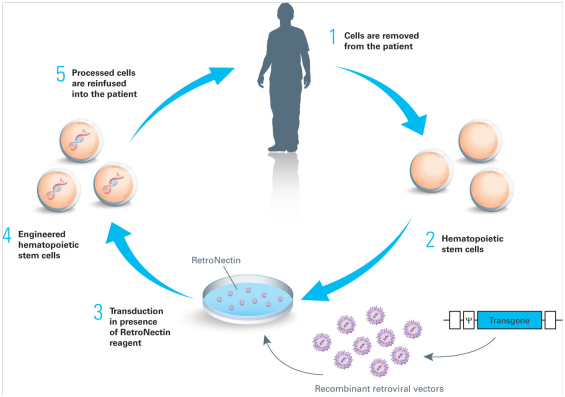What is RetroNectin®?
RetroNectin
®은 3개의 domain (cell-binding domain, heparin-binding domain, CS-1 sequence)으로 구성된 재조합 human fibronectin fragment (rFN-CH-296)으로, lentivirus/retrovirus transduction 효율 또는
T cell 확대배양 효율을 높이기 위해 사용할 수 있다.
[제품 원리-동영상]
[RetroNectin® 제품리스트]
Code |
제품명 |
용량 |
T100A |
RetroNectin® (Recombinant Human Fibronectin Fragment) |
0.5 mg (0.5 ㎖) |
T100B |
RetroNectin® (Recombinant Human Fibronectin Fragment) |
2.5 mg (2.5 ㎖) |
T110A |
RetroNectin® Dish (RetroNectin Pre-coated Dish, 35 mmφ) |
10 dishes |
T202 |
RetroNectin® GMP grade (Recombinant Human Fibronectin Fragment CH-296) |
2.5 mg (2.5 ㎖) |
How does RetroNectin® work?
 그림 1. Hypothesized mechanism of RetroNectin®-mediated enhancement of transduction
그림 1. Hypothesized mechanism of RetroNectin®-mediated enhancement of transduction
RetroNectin
®은 lentivirus 또는 retrovirus를 이용한 유전자 도입시 virus 입자와 목적 세포간의 co-localization을 도와 유전자 도입효율을 높여준다. Virus 입자와 RetroNectin
®의 H-domain이 결합하고, RetroNectin과 목적 세포의 integrin receptor 간 결합 (세포의 VLA-4와 fibronectin CS-1 site 간 결합 또는 세포의 VLA-5와 fibronectin C-domain 간 결합)함에 따라 세포와 virus가 물리적으로 가까워짐으로써 integrin receptors VLA-4 또는 VLA-5 발현 세포의 viral-mediated gene transfer 효율을 높일 수 있다.
- VLA-4 발현세포: T cells, B cells, 단핵백혈구 (monocytes), NK cells, 호산구 (eosinophils), 골수 단핵세포 (bone marrow mononuclear cells), 림프구전구세포 (lymphoid progenitor) 등
- VLA-5 발현세포: 흉선세포 (thymocytes), activated T-cells, 비만세포 (mast cells) 등
How does the use of RetroNectin® reagent?
RetroNectin
®-mediated infection 은 다음의 두 가지 방법 중 선택해서 사용한다.
- Supernatant (SN) infection method: 세포와 virus supernatant를 섞어 RetroNectin
®이 coating된 plate에 넣어주는 방법
- RetroNectin®-bound virus (RBV) infection method: RetroNectin
®이 coating된 plate에 retrovirus나 lentivirus 를 먼저 결합시킨 다음 virus supernatant를
제거하고 세포를 추가하는 방법
RBV 방법을 이용할 경우, supernatant를 먼저 제거하고 타겟세포를 추가함으로서 viral-mediated gene transduction 효율을 낮출 수 있는 바이러스 생산세포 유래의 다양한 저해물질 (proteoglycans,
외피단백질 등)을 제거할 수 있는 장점이 있다.
 그림 2. RBV infection method workflow
그림 2. RBV infection method workflow
Clinical Grade RetroNectin® reagent for ex vivo gene therapy
RetroNectin
® GMP Grade은 임상시험용의약품 (Investigational Product)을 위해 GMP 가이드라인을 준수한 시설에서 생산된 고품질 시약으로 별도의 물질 이전계약 (Material Transfer Agreement; MTA)없이
ex vivo 임상시험에 사용할 수 있다.
또한, 미국식품의약국 (U.S. Food and Drug Administration)에 Drug Master File (DMF) 제출이 완료된 제품으로, 전 세계적으로 44처의 기관에서 약 68건 이상의 gene therapy 임상실험이 진행되고 있다.
 그림 3. RetroNectin® reagent use in gene therapy research.
그림 3. RetroNectin® reagent use in gene therapy research.








